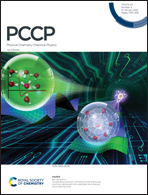The formation and migration of non-equivalent oxygen vacancies in PrBaCo2−xMxO6−δ, where M = Fe, Co, Ni and Cu†
Abstract
The ab initio calculated defect formation energies are used for assessment of high-temperature thermodynamic functions that govern the appearance of oxygen vacancies in PrBaCo2−xMxO6−δ, where M = Fe, Co, Ni and Cu. The free energy of oxygen vacancy formation is shown to depend on the dopant and total oxygen content in the cobaltite. The experimentally observed trend for the oxygen vacancy concentration to increase with the atomic number of 3d dopants from Fe to Cu is explained as a result of the decrease of bond strength. The preferable location of oxygen vacancies near impurity atoms is accompanied by an anisotropic redistribution of electronic charge density. The most pronounced development of this effect in the case of iron doping leads to a low probability of tetrahedrally coordinated iron to exist in the layered cobaltites. It is shown that the calculated enthalpies of defect formation satisfactorily explain the experimentally observed changes of oxygen non-stoichiometry in the doped cobaltite. The energy barriers for oxygen jumps are found to vary only weakly at the doping thus suggesting rather insignificant dependence of the oxygen ion conductivity on 3d dopant nature. The earlier findings and results in the present work are indicative of promising properties combination in PrBaCo2−xNixO6−δ for the application as an electrode material in IT-SOFCs.



 Please wait while we load your content...
Please wait while we load your content...